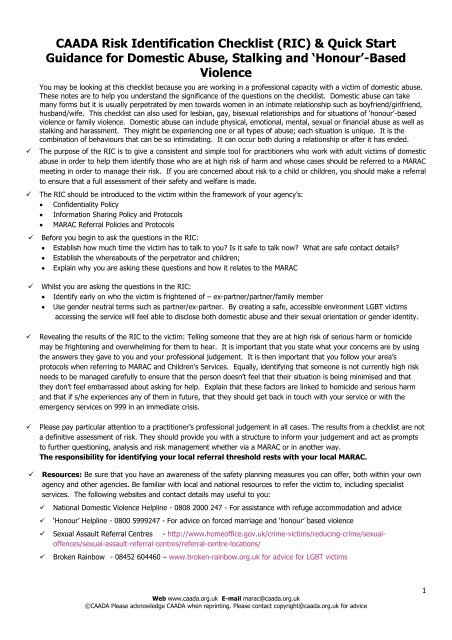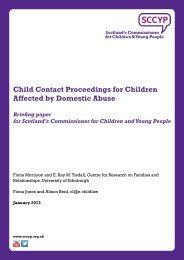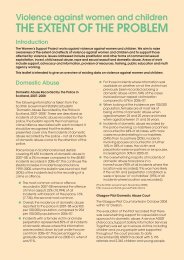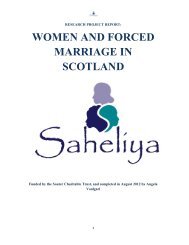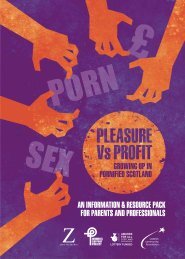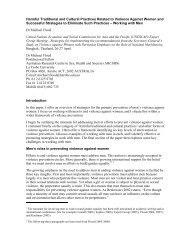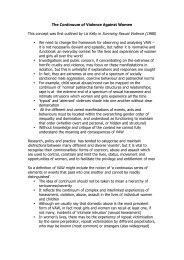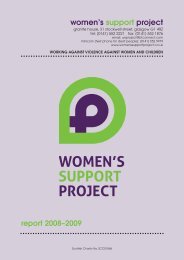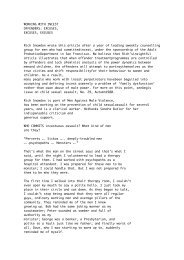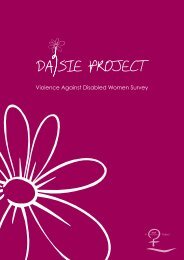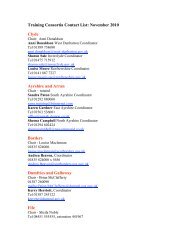CAADA-risk-assessment-form - Dorsetforyou.com
CAADA-risk-assessment-form - Dorsetforyou.com
CAADA-risk-assessment-form - Dorsetforyou.com
You also want an ePaper? Increase the reach of your titles
YUMPU automatically turns print PDFs into web optimized ePapers that Google loves.
<strong>CAADA</strong> Risk Identification Checklist (RIC) & Quick Start<br />
Guidance for Domestic Abuse, Stalking and ‘Honour’-Based<br />
Violence<br />
You may be looking at this checklist because you are working in a professional capacity with a victim of domestic abuse.<br />
These notes are to help you understand the significance of the questions on the checklist. Domestic abuse can take<br />
many <strong>form</strong>s but it is usually perpetrated by men towards women in an intimate relationship such as boyfriend/girlfriend,<br />
husband/wife. This checklist can also used for lesbian, gay, bisexual relationships and for situations of „honour‟-based<br />
violence or family violence. Domestic abuse can include physical, emotional, mental, sexual or financial abuse as well as<br />
stalking and harassment. They might be experiencing one or all types of abuse; each situation is unique. It is the<br />
<strong>com</strong>bination of behaviours that can be so intimidating. It can occur both during a relationship or after it has ended.<br />
The purpose of the RIC is to give a consistent and simple tool for practitioners who work with adult victims of domestic<br />
abuse in order to help them identify those who are at high <strong>risk</strong> of harm and whose cases should be referred to a MARAC<br />
meeting in order to manage their <strong>risk</strong>. If you are concerned about <strong>risk</strong> to a child or children, you should make a referral<br />
to ensure that a full <strong>assessment</strong> of their safety and welfare is made.<br />
The RIC should be introduced to the victim within the framework of your agency‟s:<br />
Confidentiality Policy<br />
In<strong>form</strong>ation Sharing Policy and Protocols<br />
MARAC Referral Policies and Protocols<br />
Before you begin to ask the questions in the RIC:<br />
Establish how much time the victim has to talk to you? Is it safe to talk now? What are safe contact details?<br />
Establish the whereabouts of the perpetrator and children;<br />
Explain why you are asking these questions and how it relates to the MARAC<br />
Whilst you are asking the questions in the RIC:<br />
Identify early on who the victim is frightened of – ex-partner/partner/family member<br />
Use gender neutral terms such as partner/ex-partner. By creating a safe, accessible environment LGBT victims<br />
accessing the service will feel able to disclose both domestic abuse and their sexual orientation or gender identity.<br />
Revealing the results of the RIC to the victim: Telling someone that they are at high <strong>risk</strong> of serious harm or homicide<br />
may be frightening and overwhelming for them to hear. It is important that you state what your concerns are by using<br />
the answers they gave to you and your professional judgement. It is then important that you follow your area‟s<br />
protocols when referring to MARAC and Children‟s Services. Equally, identifying that someone is not currently high <strong>risk</strong><br />
needs to be managed carefully to ensure that the person doesn‟t feel that their situation is being minimised and that<br />
they don‟t feel embarrassed about asking for help. Explain that these factors are linked to homicide and serious harm<br />
and that if s/he experiences any of them in future, that they should get back in touch with your service or with the<br />
emergency services on 999 in an immediate crisis.<br />
Please pay particular attention to a practitioner‟s professional judgement in all cases. The results from a checklist are not<br />
a definitive <strong>assessment</strong> of <strong>risk</strong>. They should provide you with a structure to in<strong>form</strong> your judgement and act as prompts<br />
to further questioning, analysis and <strong>risk</strong> management whether via a MARAC or in another way.<br />
The responsibility for identifying your local referral threshold rests with your local MARAC.<br />
Resources: Be sure that you have an awareness of the safety planning measures you can offer, both within your own<br />
agency and other agencies. Be familiar with local and national resources to refer the victim to, including specialist<br />
services. The following websites and contact details may useful to you:<br />
<br />
<br />
National Domestic Violence Helpline - 0808 2000 247 - For assistance with refuge ac<strong>com</strong>modation and advice<br />
„Honour‟ Helpline - 0800 5999247 - For advice on forced marriage and „honour‟ based violence<br />
Sexual Assault Referral Centres - http://www.homeoffice.gov.uk/crime-victims/reducing-crime/sexualoffences/sexual-assault-referral-centres/referral-centre-locations/<br />
<br />
Broken Rainbow - 08452 604460 – www.broken-rainbow.org.uk for advice for LGBT victims<br />
Web www.caada.org.uk E-mail marac@caada.org.uk<br />
©<strong>CAADA</strong> Please acknowledge <strong>CAADA</strong> when reprinting. Please contact copyright@caada.org.uk for advice<br />
1
Risk Identification Checklist Quick Start Guidance<br />
We ask about PHYSICAL ABUSE in questions 1, 10,<br />
11, 13, 15, 18, 19 & 23<br />
Physical abuse can take many <strong>form</strong>s from a push<br />
or shove to a punch, use of weapons, choking or<br />
strangulation.<br />
You should try and establish if the abuse is getting<br />
worse, or happening more often, or the incidents<br />
themselves are more serious. If your client is not<br />
sure, ask them to document how many incidents<br />
there have been in the last year and what took<br />
place. They should also consider keeping a diary<br />
marking when physical and other incidents take<br />
place.<br />
Try and get a picture of the range of physical<br />
abuse that has taken place. The incident that is<br />
currently being disclosed may not be the worst<br />
thing to have happened.<br />
The abuse might also be happening to other<br />
people in their household, such as their children or<br />
siblings or elderly relatives.<br />
Sometimes violence will be used against a family<br />
pet.<br />
If an incident has just occurred the victim should<br />
call 999 for assistance from the police. If the victim<br />
has injuries they should try and get them seen and<br />
documented by a health professional such as GP or<br />
A&E Nurse.<br />
We ask about whether the victim is experiencing any <strong>form</strong> of<br />
SEXUAL ABUSE in question 16<br />
Sexual abuse can include the use of threats, force or<br />
intimidation to obtain sex, deliberately inflicting pain<br />
during sex, or <strong>com</strong>bining sex and violence and using<br />
weapons.<br />
If the victim has suffered sexual abuse you should<br />
encourage them to get medical attention and to<br />
report this to the police. See above for advice on<br />
finding a Sexual Assault Referral Centre which can<br />
assist with medical and legal investigations.<br />
COERCION, THREATS AND INTIMIDATION is covered in questions 2, 3, 6, 8, 14, 17, 18, 19, 23 & 24.<br />
It is important to understand and establish: the fears of the victim/victims in relation to what the perpetrator/s may do; who<br />
they are frightened of and who they are frightened for (i.e. children/siblings). Victims usually know the abusers behaviour<br />
better than anyone else which is why this question is significant.<br />
In cases of „Honour‟ Based Violence there may be more than one abuser living in the home or belonging to the wider family<br />
and <strong>com</strong>munity. This could also include female relatives.<br />
Stalking and harassment be<strong>com</strong>es more significant when the abuser is also making threats to harm themselves, the victim or<br />
others. They might use phrases such as “If I can‟t have you no one else can…”<br />
Other examples of behaviour that can indicate future harm include obsessive phone calls, texts or emails, uninvited visits to<br />
the victim‟s home, workplace etc, loitering and destroyed or vandalised property.<br />
Advise the victim to keep a diary of these threats, when and where they happen, if anyone else was with them and if the<br />
threats made them feel frightened.<br />
Separation is a dangerous time: establish if the victim has tried to separate from the abuser or has been threatened about<br />
the consequences of leaving. Being pursued after separation can be particularly dangerous.<br />
Victims of domestic abuse sometimes tell us that the perpetrators harm pets, damage furniture and this alone makes them<br />
frightened without the perpetrator needing to physically hurt them. This kind of intimidation is <strong>com</strong>mon and often used as a<br />
way to control and frighten.<br />
Some perpetrators of domestic abuse do not follow court orders or contact arrangements with children. Previous violations<br />
may be associated with an increase in <strong>risk</strong> of future violence.<br />
Some victims feels frightened and intimidated by the criminal history of their partner/ex-partner. It is important to remember<br />
that offenders with a history of violence are at increased <strong>risk</strong> of harming their partner, even if the past violence was not<br />
directed towards intimate partners or family members, except for „honour‟-based violence, where the perpetrator(s) will<br />
<strong>com</strong>monly have no other recorded criminal history.<br />
Web www.caada.org.uk E-mail marac@caada.org.uk<br />
©<strong>CAADA</strong> Please acknowledge <strong>CAADA</strong> when reprinting. Please contact copyright@caada.org.uk for advice<br />
2
Risk Identification Checklist Quick Start Guidance<br />
ECONOMIC ABUSE – Question 20<br />
Victims of domestic abuse often tell us that they are financially controlled by their partners/ex-partners. Consider<br />
how the financial control impacts on the safety options available to them. For example, they may rely on their<br />
partner/ex-partner for an in<strong>com</strong>e or do not have access to benefits in their own right. The victim might feel like the<br />
situation has be<strong>com</strong>e worse since their partner/ex-partner lost their job.<br />
The Citizens Advice Bureau or the local specialist domestic abuse support service will be able to outline to the victim<br />
the options relating to their current financial situation and how they might be able to access funds in their own right.<br />
We ask about EMOTIONAL ABUSE and<br />
ISOLATION in questions 4, 5 & 12. This can<br />
be experienced at the same time as the other<br />
types of abuse. It may be present on its own<br />
or it may have started long before any physical<br />
violence began. The result of this abuse is<br />
that victims can blame themselves and, in<br />
order to live with what is happening, minimise<br />
and deny how serious it is. As a professional<br />
you can assist the victim in beginning to<br />
consider the <strong>risk</strong>s the victim and any children<br />
may be facing.<br />
CHILDREN & PREGNANCY – Questions 7, 9 & 18 refer<br />
to being pregnant and children and whether there is<br />
conflict over child contact.<br />
The presence of children including step children can<br />
increase the <strong>risk</strong> of domestic abuse for the mother.<br />
They too can get caught up in the violence and suffer<br />
directly.<br />
Physical violence can occur for the first time or get<br />
worse during pregnancy or for the first few years of<br />
the child‟s life. There are usually lots of professionals<br />
involved during this time, such as health visitors or<br />
midwives, who need to be aware of the <strong>risk</strong>s to the<br />
victim and children, including an unborn child.<br />
The perpetrator may use the children to have access<br />
to the victim, abusive incidents may occur during child<br />
contact visits or there may be a lot of fear and anxiety<br />
that the children may be harmed.<br />
Please follow your local Child Protection Procedures<br />
and Guidelines for identifying and making referrals to<br />
Children‟s Services.<br />
The victim may be being prevented from<br />
seeing family or friends, from creating any<br />
support networks or prevented from having<br />
access to any money.<br />
Victims of „honour‟ based violence talk about<br />
extreme levels of isolation and being „policed‟<br />
in the home. This is a significant indicator of<br />
future harm and should be taken seriously .<br />
Due to the abuse and isolation being suffered<br />
victims feel like they have no choice but to<br />
continue living with the abuser and fear what<br />
may happen if they try and leave. This can<br />
often have an impact on the victim‟s mental<br />
health and they might feel depressed or even<br />
suicidal.<br />
Equally the <strong>risk</strong> to the victim is greater if their<br />
partner/ex-partner has mental health problems<br />
such as depression and if they abuse drugs or<br />
alcohol. This can increase the level of isolation<br />
as victims can feel like agencies won‟t<br />
understand and will judge them. They may<br />
feel frightened that revealing this in<strong>form</strong>ation<br />
will get them and their partner into trouble<br />
and, if they have children, they may worry that<br />
they will be removed. These <strong>risk</strong>s are<br />
addressed in questions 21 & 22.<br />
Web www.caada.org.uk E-mail marac@caada.org.uk<br />
©<strong>CAADA</strong> Please acknowledge <strong>CAADA</strong> when reprinting. Please contact copyright@caada.org.uk for advice<br />
3
Risk Identification Checklist Quick Start Guidance<br />
If you are a professional working with domestic abuse and would like to know more about the Risk<br />
Identification Checklist you can find the following publications on our website:<br />
<strong>CAADA</strong>-DASH MARAC Risk Identification Checklist (RIC) 2009 for the identification of high <strong>risk</strong><br />
cases of domestic abuse, stalking and honour based violence<br />
This is the downloadable version of the RIC which has a Severity of Abuse Grid (SAG). The SAG gives<br />
practitioners the chance to profile the domestic abuse in more detail and identify significant concerns which<br />
may be relevant to include in a safety plan or share at a MARAC.<br />
Practice Guidance for Independent Domestic Violence Advisors (IDVAs) using the <strong>CAADA</strong>-DASH<br />
Risk Identification Checklist 2009<br />
This is a full and detailed guide for IDVAs and practitioners using the RIC. It takes you through the process of<br />
<strong>com</strong>pleting the RIC with your client and provides detail on why and how to ask each question. It also provides<br />
supplementary questions to gather additional detail about each <strong>risk</strong> factor and provides general safety<br />
planning advice. This is a helpful guide for IDVAs or practitioners new to the RIC and who want to be<strong>com</strong>e<br />
more familiar and confident in managing the process.<br />
<strong>CAADA</strong>-DASH Risk Identification Checklist – without guidance<br />
This is a basic version of the RIC to download and use in everyday practice.<br />
<strong>CAADA</strong>-DASH Risk Identification Checklist – Frequently Asked Questions<br />
This addresses a number of practical questions relating to the use of the checklist and the recent changes to<br />
the RIC.<br />
For additional in<strong>form</strong>ation and materials on Multi Agency Risk Assessment Conferences (MARACs), you<br />
can find the following on our website<br />
The new MARAC Guide 2009 – From Principles to Practice<br />
This provides detailed guidance on the whole MARAC process and is linked to the 11 Principles which <strong>form</strong> the<br />
basis of the Quality Assurance audit and national standards for MARAC. It is aimed to be used by MARAC<br />
steering groups, those MARACs approaching the QA audit and for MARACs who are seeking <strong>com</strong>prehensive<br />
guidance on implementation issues.<br />
MARAC Representatives’ Toolkit<br />
The representatives‟ toolkit is designed to be used by MARAC representatives who attend the MARAC meeting<br />
itself. It highlights their crucial role in each stage of the process before, during and after the meeting.<br />
Toolkits for specific practitioners attending the MARAC<br />
These are aimed at front line practitioners who may encounter a victim of abuse and consider a MARAC<br />
referral or who may be asked to undertake research on a MARAC subject or their children. The full range of<br />
agencies covered can be viewed on our website this list is being expanded regularly so please keep an eye on<br />
this page for updates.<br />
We also have a library of resources and in<strong>form</strong>ation about your nearest IDVA training course, Continuing<br />
Professional Development for IDVAs and how to develop IDVA Services through our Leading Lights<br />
programme.<br />
Web www.caada.org.uk E-mail marac@caada.org.uk<br />
©<strong>CAADA</strong> Please acknowledge <strong>CAADA</strong> when reprinting. Please contact copyright@caada.org.uk for advice<br />
4
<strong>CAADA</strong>-DASH Risk Identification Checklist (RIC)<br />
Aim of the <strong>form</strong>:<br />
To help front line practitioners identify high <strong>risk</strong> cases of domestic abuse, stalking and „honour‟-based violence.<br />
To decide which cases should be referred to MARAC and what other support might be required. A <strong>com</strong>pleted <strong>form</strong><br />
be<strong>com</strong>es an active record that can be referred to in future for case management.<br />
To offer a <strong>com</strong>mon tool to agencies that are part of the MARAC 1 process and provide a shared understanding of<br />
<strong>risk</strong> in relation to domestic abuse, stalking and „honour‟-based violence.<br />
To enable agencies to make defensible decisions based on the evidence from extensive research of cases, including<br />
domestic homicides and „near misses‟, which underpins most recognised models of <strong>risk</strong> <strong>assessment</strong>.<br />
How to use the <strong>form</strong>:<br />
Before <strong>com</strong>pleting the <strong>form</strong> for the first time we re<strong>com</strong>mend that you read the full practice guidance and Frequently<br />
Asked Questions and Answers 2 . These can be downloaded from www.caada.org.uk/marac.html<br />
Risk is dynamic and can change very quickly. It is good practice to review the checklist after a new incident.<br />
Re<strong>com</strong>mended Referral Criteria to MARAC<br />
1. Professional judgement: if a professional has serious concerns about a victim‟s situation, they should<br />
refer the case to MARAC. There will be occasions where the particular context of a case gives rise to serious<br />
concerns even if the victim has been unable to disclose the in<strong>form</strong>ation that might highlight their <strong>risk</strong> more<br />
clearly. This could reflect extreme levels of fear, cultural barriers to disclosure, immigration<br />
issues or language barriers particularly in cases of ‘honour’-based violence. This judgement would<br />
be based on the professional‟s experience and/or the victim‟s perception of their <strong>risk</strong> even if they do not meet<br />
criteria 2 and/or 3 below.<br />
2. ‘Visible High Risk’: the number of „ticks‟ on this checklist. If you have ticked 14 or more „yes‟ boxes the<br />
case would normally meet the MARAC referral criteria.<br />
3. Potential Escalation: the number of police callouts to the victim as a result of domestic violence in the<br />
past 12 months. This criterion can be used to identify cases where there is not a positive identification of a<br />
majority of the <strong>risk</strong> factors on the list, but where abuse appears to be escalating and where it is appropriate<br />
to assess the situation more fully by sharing in<strong>form</strong>ation at MARAC. It is <strong>com</strong>mon practice to start with 3 or<br />
more police callouts in a 12 month period but this will need to be reviewed depending on your local volume<br />
and your level of police reporting.<br />
Please pay particular attention to a practitioner‟s professional judgement in all cases. The results from a checklist are<br />
not a definitive <strong>assessment</strong> of <strong>risk</strong>. They should provide you with a structure to in<strong>form</strong> your judgement and act as<br />
prompts to further questioning, analysis and <strong>risk</strong> management whether via a MARAC or in another way.<br />
The responsibility for identifying your local referral threshold rests with your local MARAC.<br />
What this <strong>form</strong> is not:<br />
This <strong>form</strong> will provide valuable in<strong>form</strong>ation about the <strong>risk</strong>s that children are living with but it is not a full <strong>risk</strong><br />
<strong>assessment</strong> for children. The presence of children increases the wider <strong>risk</strong>s of domestic violence and step children are<br />
particularly at <strong>risk</strong>. If <strong>risk</strong> towards children is highlighted you should consider what referral you need to make to obtain<br />
a full <strong>assessment</strong> of the children‟s situation.<br />
1<br />
For further in<strong>form</strong>ation about MARAC please refer to the <strong>CAADA</strong> MARAC Implementation Guide www.caada.org.uk.<br />
2<br />
For enquiries about training in the use of the <strong>form</strong>, please email training@caada.org.uk or call 0117 317 8750.<br />
Web www.caada.org.uk E-mail marac@caada.org.uk<br />
©<strong>CAADA</strong> Please acknowledge <strong>CAADA</strong> when reprinting. Please contact copyright@caada.org.uk for advice<br />
5
<strong>CAADA</strong>-DASH Risk Identification Checklist for use by IDVAs and other non-police agencies 3 for<br />
MARAC case identification when domestic abuse, ‘honour’- based violence and/or stalking are<br />
disclosed<br />
Please explain that the purpose of asking these questions is for the safety<br />
and protection of the individual concerned.<br />
Tick the box if the factor is present . Please use the <strong>com</strong>ment box at the<br />
end of the <strong>form</strong> to expand on any answer.<br />
It is assumed that your main source of in<strong>form</strong>ation is the victim. If this is<br />
not the case please indicate in the right hand column<br />
Yes<br />
(tick)<br />
No<br />
Don‟t<br />
Know<br />
State<br />
source of<br />
info if not<br />
the victim<br />
e.g. police<br />
officer<br />
1. Has the current incident resulted in injury?<br />
(Please state what and whether this is the first injury.)<br />
2. Are you very frightened?<br />
Comment:<br />
3. What are you afraid of? Is it further injury or violence? (Please give<br />
an indication of what you think (name of abuser(s)...) might do and to<br />
whom, including children).<br />
Comment:<br />
4. Do you feel isolated from family/friends i.e. does (name of<br />
abuser(s) ………..) try to stop you from seeing friends/family/doctor or<br />
others?<br />
Comment:<br />
5. Are you feeling depressed or having suicidal thoughts?<br />
6. Have you separated or tried to separate from (name of<br />
abuser(s)….)<br />
within the past year?<br />
7. Is there conflict over child contact?<br />
8. Does (……) constantly text, call, contact, follow, stalk or harass<br />
you?<br />
(Please expand to identify what and whether you believe that this is<br />
done deliberately to intimidate you? Consider the context and<br />
behaviour of what is being done.)<br />
9. Are you pregnant or have you recently had a baby<br />
(within the last 18 months)?<br />
10. Is the abuse happening more often?<br />
11. Is the abuse getting worse?<br />
12. Does (……) try to control everything you do and/or are they<br />
excessively jealous? (In terms of relationships, who you see, being<br />
„policed at home‟, telling you what to wear for example. Consider<br />
„honour‟-based violence and specify behaviour.)<br />
13. Has (……..) ever used weapons or objects to hurt you?<br />
3 Note: This checklist is consistent with the ACPO endorsed <strong>risk</strong> <strong>assessment</strong> model DASH 2009 for the police<br />
service.<br />
Web www.caada.org.uk E-mail marac@caada.org.uk<br />
©<strong>CAADA</strong> Please acknowledge <strong>CAADA</strong> when reprinting. Please contact copyright@caada.org.uk for advice<br />
6
Tick box if factor is present. Please use the <strong>com</strong>ment box at the end of the<br />
<strong>form</strong> to expand on any answer.<br />
Yes<br />
(tick)<br />
No<br />
Don‟t<br />
Know<br />
State<br />
source<br />
of info if<br />
not the<br />
victim<br />
14. Has (……..) ever threatened to kill you or someone else and you<br />
believed them? (If yes, tick who.)<br />
You Children Other (please specify) <br />
15. Has (………) ever attempted to strangle/choke/suffocate/drown you?<br />
16. Does (……..) do or say things of a sexual nature that make you feel<br />
bad or that physically hurt you or someone else? (If someone else,<br />
specify who.)<br />
17. Is there any other person who has threatened you or who you are<br />
afraid of? (If yes, please specify whom and why. Consider extended<br />
family if HBV.)<br />
18. Do you know if (………..) has hurt anyone else? (Please specify<br />
whom including the children, siblings or elderly relatives. Consider<br />
HBV.)<br />
Children Another family member <br />
Someone from a previous relationship Other (please specify) <br />
19. Has (……….) ever mistreated an animal or the family pet?<br />
20. Are there any financial issues? For example, are you dependent on<br />
(…..) for money/have they recently lost their job/other financial issues?<br />
21. Has (……..) had problems in the past year with drugs<br />
(prescription or other), alcohol or mental health leading to problems in<br />
leading a normal life? (If yes, please specify which and give relevant<br />
details if known.)<br />
Drugs Alcohol Mental Health <br />
22. Has (……) ever threatened or attempted suicide?<br />
23. Has (………) ever broken bail/an injunction and/or <strong>form</strong>al agreement<br />
for when they can see you and/or the children? (You may wish to<br />
consider this in relation to an ex-partner of the perpetrator if relevant.)<br />
Bail conditions Non Molestation/Occupation Order <br />
Child Contact arrangements <br />
Forced Marriage Protection Order Other <br />
24. Do you know if (……..) has ever been in trouble with the police or<br />
has a criminal history? (If yes, please specify.)<br />
DV Sexual violence Other violence Other <br />
Total „yes‟ responses<br />
Web www.caada.org.uk E-mail marac@caada.org.uk<br />
©<strong>CAADA</strong> Please acknowledge <strong>CAADA</strong> when reprinting. Please contact copyright@caada.org.uk for advice<br />
7
For consideration by professional: Is there any other relevant in<strong>form</strong>ation (from victim or professional) which<br />
may increase <strong>risk</strong> levels? Consider victim‟s situation in relation to disability, substance misuse, mental health issues,<br />
cultural/language barriers, „honour‟- based systems and minimisation. Are they willing to engage with your service?<br />
Describe:<br />
Consider abuser‟s occupation/interests - could this give them unique access to weapons? Describe:<br />
What are the victim‟s greatest priorities to address their safety?<br />
Do you believe that there are reasonable grounds for referring this case to MARAC? Yes / No<br />
If yes, have you made a referral? Yes/No<br />
Signed:<br />
Do you believe that there are <strong>risk</strong>s facing the children in the family? Yes / No<br />
If yes, please confirm if you have made a referral to safeguard the children: Yes / No<br />
Date referral made …………………………………………….<br />
Date:<br />
Signed:<br />
Date:<br />
Name:<br />
Practitioner‟s Notes<br />
Web www.caada.org.uk E-mail marac@caada.org.uk<br />
©<strong>CAADA</strong> Please acknowledge <strong>CAADA</strong> when reprinting. Please contact copyright@caada.org.uk for advice<br />
8


